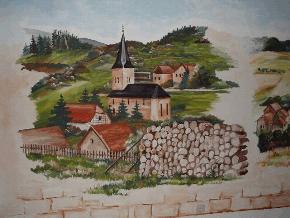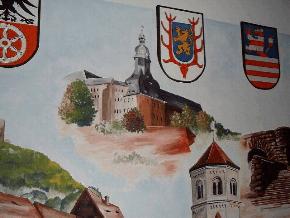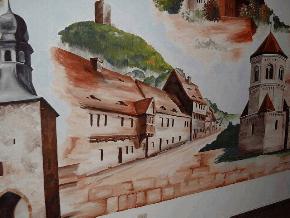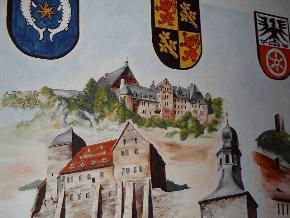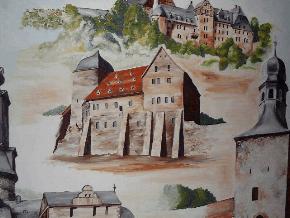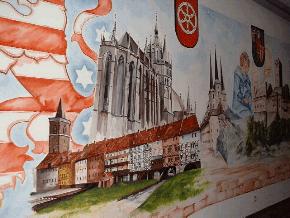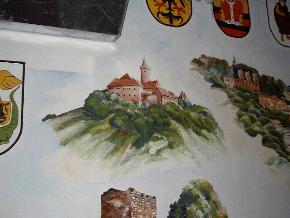The wall paintings of the modelrailway Wiehe: Castles; Painter: Hans Tempel
Dear Readers! What has the model railway Wiehe to do with the history of Thuringia and Saxony-Anhalt? When I started in autumn 1996, the two model installations for the landscape them of Thuringia and Harz to plan, I had the idea to create the walls of the exhibition halls with motifs of historically valuable and interesting buildings in Thuringia and Saxony-Anhalt. In the painter Hans Tempel, I found a partner who clearly knew my creative and implement my ideas. As planned from the start to create a publication on the wall, was deliberately avoided the name and the name of place of the respective subject. We think rather that it is an interesting and instructive task can apper on a separate sheet attached to the cost of arms, the magazine assigned depicted motifs from our exhibition hall. So anyone can even determine which coat of arms belongs to which picture and what historical events behind it. To make the whole thing round, the historian Dr. Franz Rittig prepared on each image detailed historical texts in the example of the history of our homland convey, without a didactic effect. Especially important it was to remember the older German history, which I believe is still given little attention, too.
Wiehe is in the Unstrut valley, the "Valley of the kings and emperors". Here the Emperor Otto I. built once the old Pfalz of Memleben to a significant center of power to ist strong central authority overe the entire Germany. Even the subsequent emperors Otto II. And Otto 3rd. enjoyed Memlebend with the highest esteem. Therefore, Unstrut make German history, that goes far beyond the region - a fact, that was making due consideration of the motif selection as well as the text. So we learn from the booklet, how it cames to the construction of the depicted castles and churches. One reads, when and why towns and cities emerged, while castles and forts were abandoned and fell apart. There are memories of cruel wars, but I think also is thought of peacefule times. From emperors and kings are the speech, but also by the reformer Martin Luther and by the peasant leader and preacher Thomas Müntzer and his valiant companions. In short, with our images and coat of arms is an issue perhaps only small, but interesting journey through the history of Saxony-Anhalt and Thuringia is possible. Stiegler, in June 1998.




